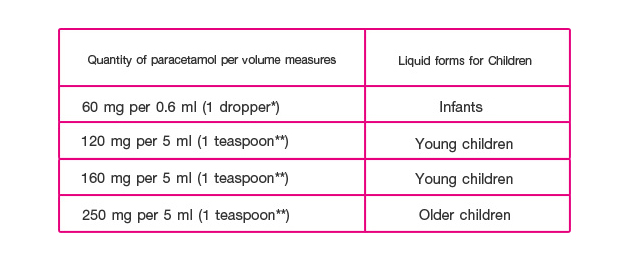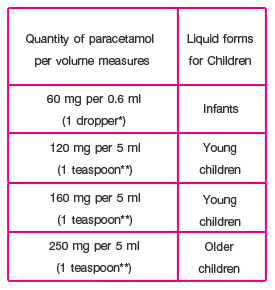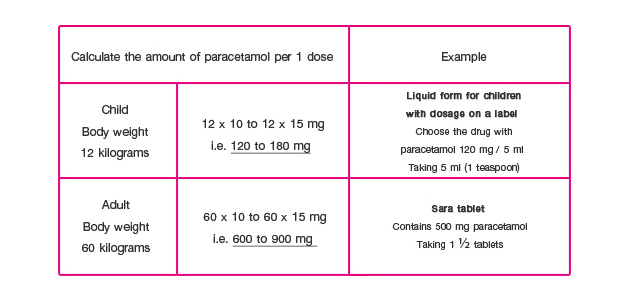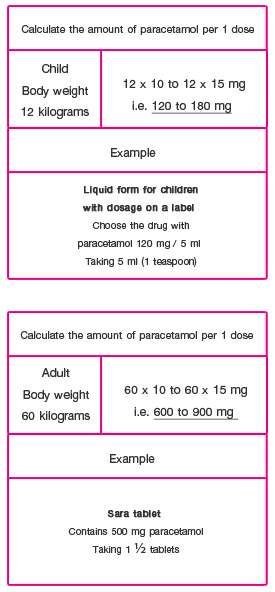Q&A
For a safe and correct use of medicines, please read drug labels or information leaflets carefully, and strictly follow your doctor/pharmacist’s advice. If you have any questions or concerns about your medicines, always ask your doctor or pharmacist before taking them.
FAQs SARA Paracetamol
Answered by Chompoonut Masavisut, Pharmacist, Product Manager, Thai Nakorn Patana Co., Ltd.
1. What type of medicine is SARA?
SARA is a pain and fever reliever. Its active ingredient is paracetamol. SARA is available in tablet for adults and liquid forms for children.
Tablets are offered in round tablet and caplet shapes, just different forms for user convenience. Both round tablet and caplet have same dose; each tablet contains 500 mg paracetamol.
Liquid forms for children are offered in different concentrations of paracetamol in order to provide a correct dose, which depends on children’s weight. The details are as follows:


Description
- dropper* refers to a liquid dropper for an infant, which is marked 0.6 ml and 0.3 ml
- teaspoon** refers to a graduated spoon which hold 5 ml.
Both dropper and teaspoon are usually provided within the medicine package, or by the hospital/clinic.
- The volume of 1 ml is equal to 1 cc.
2. How does Paracetamol relieve pain and fever?
Paracetamol works by making the body system feel less pain and helping reduce the body temperature, which is higher than normal when we have fever.
3. What is considered a fever?
Taken with a thermometer, body temperatures above 37.5ºC are considered to be above normal and elevation of body temperature is called fever. Fever may be resulted from infection, dehydration, injury, or other abnormalities occurring in the body.
4. How to take paracetamol?
- For adults: 1-2 tablets every 4-6 hours as required for relieving pain or fever. Maximum daily dose should not exceed 8 tablets (4,000 mg).
- For children: The doctor/pharmacist will calculate single and daily doses for children which depend on their bodyweight.
5. Is paracetamol safe?
Paracetamol is safe and effective if used as recommended on the label or drug information leaflet or as directed by the doctor/pharmacist. The important thing is that do not take it more than the recommended dose because it may cause liver damage.
6. Will there be any difference in term of efficacy and safety if pharmaceutical raw materials come from different sources?
As there are specifications of the standard active ingredients, such as for quantity, purity, contamination, etc., written in the pharmaceutical formularies that are used with international standards, raw materials from various sources should basically meet the same or similar standards. On the other hand, some manufacturers can even manage to reduce contamination in raw materials and that results in safety enhancement.
7. What is special about SARA’s Paracetamol from Mallinckrodt Pharmaceuticals?
Mallinckrodt Pharmaceuticals manufactures Paracetamol that has high purity and low level of contamination*. These make it different in terms of efficacy and safety.
*Contamination refers to chemicals that occur during medicine manufacturing processes. Some are dangerous to the body system. Therefore, the level of contamination must be low in high-quality medicine.
*One example of contamination in paracetamol is p-Aminophenol, which affects liver function. According to United States Pharmacopeia (USP), the acceptable limit for p-Aminophenol in paracetamol is not more than 50 ppm. (parts per million), while Mallinckrodt’s Paracetamol contains it less than 2 ppm.
Besides, medicine manufacturers have to obtain permissions from Department of Public Health’s Food and Drug Administration (FDA) in order to manufacture or import drugs. Consumers can be ensured that all the registered drugs are effective and safe as they have met the Ministry’s standards. However, there are some other factors, from the manufacturers, that affect efficacy and safety of the medicines such as raw material source selection, manufacturing technology, process of quality control, etc.
8. Does paracetamol cause stomach upset?
Paracetamol does not cause stomach upset. Digested food in the stomach does not prevent absorption of paracetamol either. So, it can be taken on an empty stomach or after meal.
9. What medicine causes stomach upset?
There are some medicines that can upset stomach. They must be taken with or immediately after meal to reduce irritation. They should not be taken on an empty stomach. Examples of these medicines are drugs for joint pain (medical term, Non-Steroidal Anti-Inflammatory Drugs – NSAIDs), such as Aspirin, Ibuprofen, Diclofenac, etc.
10. Can a patient with stomach ulcer take paracetamol?
Yes, because paracetamol is considered gastrointestinal safe and does not irritate stomach.
11. What is the difference between SARA’s round tablet and caplet?
- SARA offers both shapes of tablets just for customer convenience. Besides, there is no other difference.
- Both round tablet and caplet contain 500 mg paracetamol.
12. Why does SARA’s liquid form for children come in various flavors and several different strengths?
When prescribing paracetamol, the doctor/pharmacist must calculate correct dose for each patient, especially a child, who is more susceptible to overdose dangers. Therefore, SARA offers several different concentrations in order to provide a correct dose for children with different weights.


Description
- dropper* refers to a liquid dropper for an infant, which is marked 0.6 ml and 0.3 ml
- teaspoon** refers to a graduated spoon which hold 5 ml.
Both dropper and teaspoon are usually provided within the medicine package, or by the hospital/clinic.
- The volume of 1 ml is equal to 1 cc.
13. How to calculate single dose of paracetamol according to body weight?
There are medical researches to determine the standard dose of every drug for treating symptoms. The dose must be high enough to be effective but not too high to be harm.
Most medications are prescribed to a patient at each dose and the dose depends on body weight.
Paracetamol is usually given at single dose* of 10-15 mg/kg body weight every 4-6 hours only when required to relieve symptoms. It is not necessary to take the medicine if no pain or fever.
Source* Drug Information Handbook : American Pharmacists Association 24th 2015-2016 page 34.
Example of calculating the amount of paracetamol in 1 dose.


- To give liquid form for children, the dose must be accurately calculated according to dosage on the label, which specifies the amount of drug per 1 teaspoon.
14. Can pregnant women take paracetamol?
Yes. It is accepted that paracetamol is a safe alternative pain relievers for pregnant women, compared to pain relievers in other groups. However, it must be taken as recommended in the drug information leaflet.
Pregnant women should consult a doctor or pharmacist for recommendation and cautions.
15. Can breastfeeding women take paracetamol?
Yes. Paracetamol is a safe alternative pain relievers for breastfeeding women, compared to drugs in other groups. However, it must be taken as stated in the drug information leaflet.
Lactating mothers should consult a doctor or pharmacist for recommendation and cautions.
16. Are there any precautions to take when taking paracetamol?
- Do not take paracetamol over the prescribed dose on the label or drug information leaflet.
- Do not take it with other medicines that also contain paracetamol.
- Those with liver or kidney disease should consult a doctor or pharmacist before taking it.
- Those with alcohol dependence should consult a doctor or pharmacist before taking it.
17. Does paracetamol have any side effects?
Taking paracetamol at the recommended dose (according to drug information leaflet) rarely causes side effects. The symptom it may cause is skin rash, for example
Source* Drug Information Handbook : American Pharmacists Association 24th 2015-2016 page 33.
18. The facts about paracetamol affecting the liver.
Either food, medicines, or vitamins normally contain substances that affect our bodies, not only liver, kidney, but also other organs. There are factors from the receivers, including age; gender; race; physical condition of each person; quantity and duration of exposure; liver and kidney conditions as they are the organs of excretion, and intrinsic factors of substances which include form; quantity and duration of exposure; and the effects that occur with other substances received simultaneously.
If we take an overdose of medicine, the liver and kidney have to work harder and problems may occur.
As paracetamol is excreted by the liver, in a person with normal liver function, taking the drug at the recommended dose in the information leaflet will not cause liver problem. Therefore, do not take it more than the dose directed by the doctor or pharmacist. It should be taken as required no sooner than 4-6 hours after the last dose.
- For adults: Maximum daily dose should not exceed 4,000 mg or 8 tablets.
- For children: The drug must be strictly given in the prescribed dose and a maximum of 5 doses daily.
- For patients with liver or kidney disease, it must be taken under the doctor’s supervision only.
Source
- United States National Library of Medicine : Drug Record Acetaminophen
- Drug Information Handbook: American Pharmacists Association 24th 2015-2016 page 33.
19. How long can one safely take paracetamol?
Paracetamol should not be taken for more than 5 consecutive days. In case of continuous pain or fever, please go to see a doctor for examination and diagnosis.
20. What is the shelf life of Sara tablets?
It is 5 years from the manufactured date with optimum storage. The tablets should be stored away from light, heat, and moisture, under 30ºC, and kept out of reach of children.
Any medicine that has changed from its original appearance such as color change, getting spots or moist, etc., is considered damaged due to improper storage and should not be taken.
21. What is the shelf life of Sara in liquid form?
It is 5 years from the manufactured date with optimum storage. The medicine should be stored away from light, heat, and moisture, under 25ºC, and kept out of reach of children.
Any medicine that has changed from its original appearance such as color change, smell, sedimentation, etc., is considered damaged due to improper storage and should not be taken.
22. What is the amount of 1 teaspoonful of liquid medicine?
According to the measurement, 1 teaspoonful* is equivalent to 5 ml (or 5 cc).
Teaspoon* here refers to a graduated spoon which hold 5 ml (or 5 cc).
A teaspoon is usually provided within the medicine package, or by the hospital/clinic.
23. Is it necessary to shake the bottle before taking liquid medicine?
It is necessary as the patient has to take medicine in the correct dosage. Always shake the bottle before use in order to have all the ingredients well mixed.
24. What is the advantage of “Sugar free” liquid medicine for children?
Because most of the drug powders used to make liquid medicine have bitter taste or smell that children do not like and refuse to take it, drug manufacturers then add sweeteners, mostly syrup, i.e. sugar, to help reduce the bitterness.
Liquid medicines with “Sugar Free" labels is the drugs that the manufacturers have chosen other sweeteners, which is safe for children, instead of sugar, such as sorbitol. It is good for child health as the children will not have unnecessary sugar intake.
25. What is the advantage of “Alcohol free” liquid medicine for children?
The dissolution of the drug powders and making of liquid medicines usually use various substances to make stable forms of the medicines. (Stability of the drug means that if the drug is kept in optimum storage, its active ingredients can maintain standards of quantity and efficacy throughout its shelf life without deterioration.) Alcohol is one of the substance used in liquid medicine manufacturing for such purpose.
Liquid medicines with “Alcohol Free" labels is the drugs that the manufacturers have developed pharmaceutical formulations to use the other safe substances instead of alcohol for more safety.